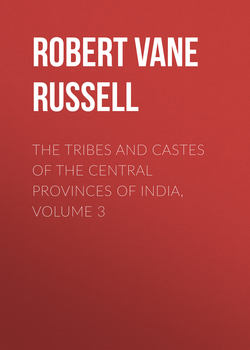Читать книгу The Tribes and Castes of the Central Provinces of India, Volume 3 - Robert Vane Russell - Страница 12
Gandhmāli
ОглавлениеGandhmāli,15 Thānāpati.—The caste of village priests of the temples of Siva or Mahādeo in Sambalpur and the Uriya States. They numbered about 700 persons in the Central Provinces in 1911. The caste appears to be an offshoot of the Mālis or gardeners, differentiated from them by their special occupation of temple attendants. In Hindustān the priests of Siva’s temples in villages are often Mālis, and in the Marātha country they are Guraos, another special caste, or Phulmālis. Some members of the caste in Sambalpur, however, aspire to Rājpūt origin and wear the sacred thread. These prefer the designation of Thānāpati or ‘Master of the sacred place,’ and call the others who do not wear the thread Gandhmālis. Gandh means incense. The Thānāpatis say that on one occasion a Rājpūt prince from Jaipur made a pilgrimage to the temple of Jagannāth at Puri, and on his return stopped at the celebrated temple of Mahādeo at Huma near Sambalpur. Mahādeo appeared before the prince and asked him to become his priest; the Rājpūt asked to be excused as he was old, but Mahādeo promised him three sons, which he duly obtained and in gratitude dedicated them to the service of the god. From these sons the Thānāpatis say that they are descended, but the claim is no doubt quite illusory. The truth is, probably, that the Thānāpatis are priests of the temples situated in towns and large villages, and owing to their calling have obtained considerable social estimation, which they desire to justify and place on an enduring basis by their claim to Rājpūt ancestry; while the Gandhmālis are village priests, more or less in the position of village menials and below the cultivating castes, and any such pretensions would therefore in their case be quite untenable. There are signs of the cessation of intermarriage between the two groups, but this has not been brought about as yet, probably owing to the paucity of members in the caste and the difficulty of arranging matches. Three functional subdivisions also appear to be in process of formation, the Pujāris or priests of Mahādeo’s temples, the Bandhādias or those who worship him on the banks of tanks, and the Mundjhulas16 or devotees of the goddess Somlai in Sambalpur, on whom the inspiration of the goddess descends, making them shake and roll their heads. When in this state they are believed to drink the blood flowing from goats sacrificed in the temple. For the purposes of marriage the caste is divided into exogamous groups or bargas, the names of which are usually titles or designations of offices. Marriage within the barga is prohibited. When the bride is brought to the altar in the marriage ceremony, she throws a garland of jasmine flowers on the neck of the bridegroom. This custom resembles the old Swayamwāra form of marriage, in which a girl chose her own husband by throwing a garland of flowers round his neck. But it probably has no connection with this and merely denotes the fact that the caste are gardeners by profession, similar ceremonies typifying the caste calling being commonly performed at marriages, especially among the Telugu castes. Girls should be married before adolescence and, as is usual among the Uriya castes, if no suitable husband is forthcoming a symbolic marriage is celebrated; the Thānāpatis make her go through the form with her maternal grandfather or sister’s husband, and in default of them with a tree. She is then immediately divorced and disposed of as a widow. Divorce and the remarriage of widows are permitted. A bachelor marrying a widow must first go through the ceremony with a flower. The Gandhmālis, as the priests of Mahādeo, are generally Saivas and wear red clothes covered with ochre. They consider that their ultimate ancestor is the Nāg or cobra and especially observe the festival of Nāg-Panchmi, abstaining from any cooked food on that day. They both burn and bury the dead and perform the shrāddh ceremony or the offering of sacrificial cakes. They eat flesh but do not drink liquor. Their social position is fairly good and Brāhmans will take water from their hands. Many of them hold free grants of land in return for their services at the temples. A few are ordinary cultivators.
15
This article is compiled from papers by Mr. Jhanjhan Rai, Tahsīldār, Sārangarh, and Satyabādi Misra of the Sambalpur Census office.
16
Mund-jhulānā, to swing the head.
